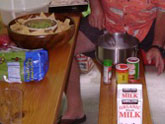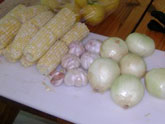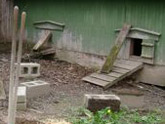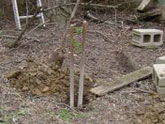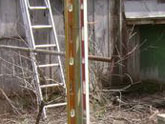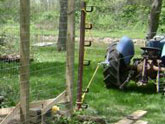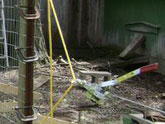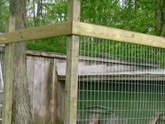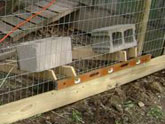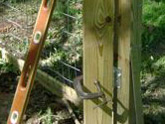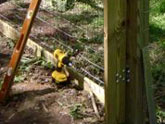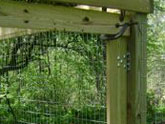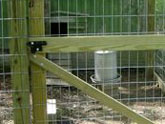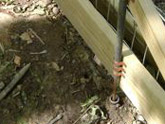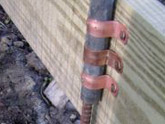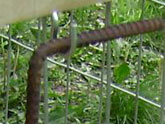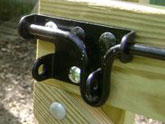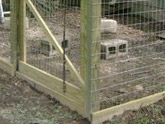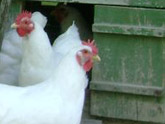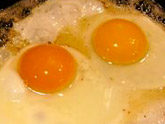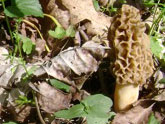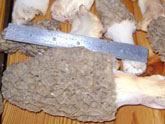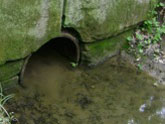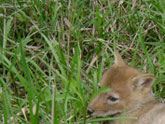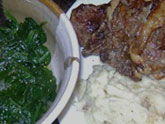May 22, 2009
Cajun Party in Ostrander
On Thursday, May 21st, after loading their truck, Chris Cancienne and Joe Territa left Gonzales in southern Louisiana headed for Ostrander, Ohio. Their cargo included two 40 lb sacks of crawfish, 20 lbs of fresh Gulf shrimp, some soft-shell crabs, and 2 large ZipLocks of catfish filets from Lake Verette that Chris caught, as well as a 100 gallon boiling pot, a propane burner to fire it, and all the seasonings required for a crawfish boil and fish fry, Cajun style. We supplied the beer and a hungry audience of 20 Yankees.
 |
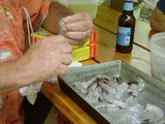 |
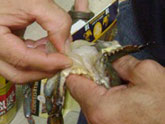 |
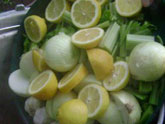 |
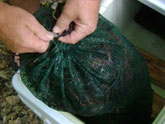 |
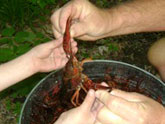 |
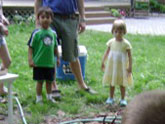 |
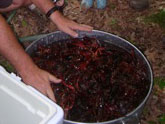 |
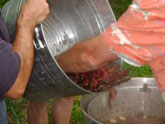 |
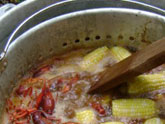 |
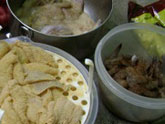 |
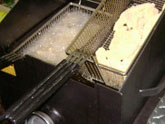 |
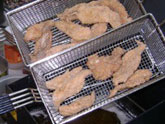 |
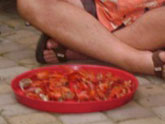 |
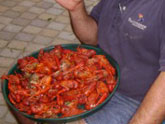 |
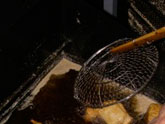 |
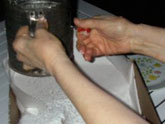 |
May 4-18, 2009
Penning up the hens
We've had White Rocks for eggs these past two years. They're not my favorite yard bird.
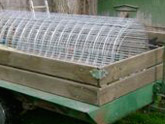 Our garden is on the other side of the frog pond from the hen house. Barred Rocks, Rhode Island Reds and Wyandottes, like White Rocks, are big, dual-purpose birds, but they are more docile and less flighty. They don't travel far. White Rocks do. They took the footbridge across the pond late in the growing season last year and discovered the garden. I fenced off the bridge, but they found their way around via the dam. The protective electric fence surrounding the garden works for deer and varmints such as groundhogs and rabbits, but chickens come insulated. White Rocks fashioned dust bowls among the tomatoes and pecked holes in ripe fruit and vegetables.
Our garden is on the other side of the frog pond from the hen house. Barred Rocks, Rhode Island Reds and Wyandottes, like White Rocks, are big, dual-purpose birds, but they are more docile and less flighty. They don't travel far. White Rocks do. They took the footbridge across the pond late in the growing season last year and discovered the garden. I fenced off the bridge, but they found their way around via the dam. The protective electric fence surrounding the garden works for deer and varmints such as groundhogs and rabbits, but chickens come insulated. White Rocks fashioned dust bowls among the tomatoes and pecked holes in ripe fruit and vegetables.
We seldom kept the old henhouse fence gated. I'd fashioned it years earlier supported by rails welded up from scrap galvanized water pipe. It's since deteriorated, but I've continued raising layers and broilers without one, sacrificing a few now and then to predators. Even considering a Great Horned Owl that killed 18 broilers in one night, and a Red-tailed hawk that got greedy over the course of a spring, and also the occasional squirrel dog pup that runs down a few before it's corrected, the exchange has been worth it for the quality of eggs and meat returned.
No egg rivals one from a hen that can go where she wants and do what she wants. Give me eggs from breeds proficient in foraging for a living, that are thrown a handful of cracked corn in the morning, and from there venture forth into the world of insects, worms, seeds, duff, etc, to scratch out a living. Yard birds don't lay eggs every day, but their eggs are as different in taste within the family of eggs as wild morels are to button mushrooms grown down mine shafts.
Consider a commercial egg-farm egg. Its weak yellow yolk flattens out like it wants to hide from the light, and no one outside of a paid spokesman would endorse its flavor. The yolk remaining on the breakfast plate rinses off without much resistance. By every measure, it's ashamed of life. Even premium commercial organic eggs that come from laying hens on high-protein diets lack substance, color and taste.
You can also spot an egg from a foraging hen by the yolk's color, which resembles the morning sun, and by the way it sits up in a skillet and swims in bacon grease without fear. As for the texture and taste, well, do you prefer sun-ripened garden tomatoes grown in fertile soil to mealy hothouse substitutes?
This is the last year here for the White Rocks because of their wanderlust. I'll replace them with some Wyandotte chicks when we purchase our Rock-Cornish broiler chicks later this summer. Until then, I'll restrict their range.
To that end, I replaced the henhouse fence. Just in time, too. The potatoes have grown a foot tall since I began the project, and the hens found the dirt there suitable for dusting themselves, exposing potato roots in the process.
With the hens penned up for the rest of the summer growing season, the eggs will slowly lose quality. Their color will pale and the yolks won't grab hold of toast. Oh, they'll still be better than anything I can buy in town, but they won't be the best eggs that a domestic situation can produce. The gate swinging shut began their long farewell. Eventually, we'll be forced to pair the hickory-smoked bacon with juicy, red garden tomatoes.
May 6, 2009
When the house wrens sing
A mushroom hunter is furtive by nature and a poacher by disposition because he believes that mushrooms belong to whoever finds them wherever he finds them. I'm so careful to guard my morel patches that I wear dark clothes when I visit them, and I never go in the evenings, when folks might be doing yard work and see me. I never step where I might leave a footprint, such as at creek crossings or upon bare-earth spots along tractor paths, and I'm careful to cover every trimming before I lay the mushroom in my onion sack. I want to leave no sign that I've been there, and even less sign what I've been up to. A mushroom hunter will gladly tell you what he found, when he found them, or how many he found, but he will never tell you where he found them.
I search elsewhere, but depend primarily on 5 spots in four separate woods. Morels are not predictable, but these patches produce as reliably as any. The season begins when the May apples and asparagus come up, when the first house wrens begin warbling. It's early in the season, as the find of 18 greys yesterday evening would indicate. They tend to precede the more abundant yellows.
One of these five locations has produced morels off and on since we moved here, and was known to at least 5 other mushroom hunters, 3 from the same family—the landowner and his two sons. Three are dead, a fourth grown old and indifferent, and the fifth crippled by age, but I seldom go there without kindling fond memories because we were once friendly acquaintances and competitors on a first-come, first-served basis. I carry a share to the fifth man when I find them there.
My most productive spot over time has been an old, overgrown apple orchard tucked on a hillside only 200 yards from a residence. I searched it hard yesterday evening after the first find, but it yielded only a plastic grocery sack tangled in the briars. It wasn't there three days earlier. Blown there or dropped by a careless 'shroomer? So I went to the creek crossing on the game trail below it. Sure enough, fresh boot prints in the mud. It's disheartening to know that I'm sharing my spot with another gatherer who is slovenly in his habits and disrespectful of the morels through his use of plastic bags. I'll start visiting there in the early morning henceforth.
May 4, 2009
Asparagus, old and new
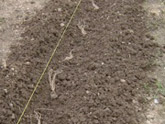 My father-in-law started our first asparagus bed about 40 years ago the old-fashioned way. He dug a trench two foot deep and we filled it with rotted manure, a layer of dirt, and then we carefully spread the roots of each crown as we bedded them upright. During the course of that summer, I laid on more dirt as the asparagus grew until the bed was level. The variety was Mary Washington, and it included both male and female plants. We didn't pick asparagus until the third year of growth. There's still a shallow depression near the garden marking the length of the old bed, like a sunken grave.
My father-in-law started our first asparagus bed about 40 years ago the old-fashioned way. He dug a trench two foot deep and we filled it with rotted manure, a layer of dirt, and then we carefully spread the roots of each crown as we bedded them upright. During the course of that summer, I laid on more dirt as the asparagus grew until the bed was level. The variety was Mary Washington, and it included both male and female plants. We didn't pick asparagus until the third year of growth. There's still a shallow depression near the garden marking the length of the old bed, like a sunken grave.
The last bed was comprised of all male plants, but I still bedded it in manure, the old way. I also mixed in some mint with it, hoping to crowd out weed growth while gathering quantities of the herb for drying. That was a mistake. The mint is so aggressive that it choked out the asparagus and the bed lasted less than 10 years.
The bed I made today is a bed in name only, and marks the first one I've planted directly in the garden proper. I researched asparagus online and followed recommendations that require much less preparation with the promise of greater dividends. I scooped aside a six inch trench in tilled, fertile soil on the western edge of the garden, tossed in 30 male crowns at 1 ½ foot intervals every which way, and covered them level. The online source also recommends picking asparagus spears next year. We'll see. I value the old ways, but I like asparagus bounty and the ways that work, too.



